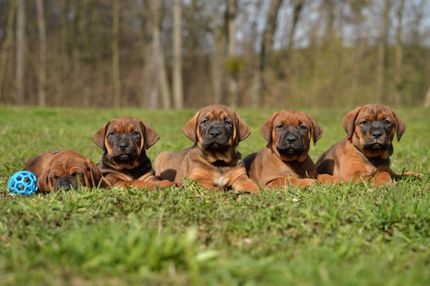
Saint Bernewfie:Saint Bernard and Newfoundland Mix
Facts & Origin
St. Bernard and Newfoundland mix - a hybrid breed
If you like huge dogs, then the Saint Bernard and Newfoundland mix might be just the thing for you. Both are large family dogs and as such, they have a very friendly nature. In addition, both dogs are very friendly with children, which makes them a good choice for families.
What are breed characteristics of this mix dog?
The Saint Bernard Newfoundland mix has a dense and long coat that is either brown, black or brindle. They have a large head with a square muzzle and floppy ears. Their body is muscular and stocky, with a deep chest. They usually weigh between 60-70 kg and are 60-70 cm tall.




| Alternate Name | - |
| Origin | Switzerland - Canada |
| Life expectancy | 8 - 10 years |
| Care requirements | high-maintenance |
| Activity level | average |
| FCI group | not recognised |
| AKC group | not recognised |
| KC group | not recognised |
More Saint Bernard mixes
More Newfoundland mixes
Attitude, character and temperament of the breed
Possible character traits of Saint Bernewfie Mix - Such is probably his nature.
Although both are incredibly large breeds, Saint Bernards and Newfoundlands are very different in build. The Saint Bernard is more muscular, while the Newfoundland is larger and has heavier bones. But when you put these two gentle giants together, you get a dog that is both strong and sturdy. The St. Bernard-Newfoundland mix is a loyal and loving companion that is perfect for families with young children. Although not as well known as other mixed breeds, they are quickly becoming a popular choice for those looking for a large, gentle dog.
Character
Usage


Health and breeding information
What diseases can occur in St. Bernard-Fundlander mix.
The St. Bernard-Newfoundland mix is a large, muscular dog with a thick coat. He is known for his gentle nature and loyalty, but can be stubborn at times. This breed is a mix of St. Bernard and Newfoundland, two breeds known for their excellent swimming abilities.
The St. Bernard-Newfoundland mix is prone to some of the same health problems as the two parent breeds. These health problems include hip and elbow dysplasia, heart disease, flatulence and cancer. The good news is that most of these health problems can be prevented or at least controlled with proper diet and exercise.
Hip and elbow dysplasia are two of the most common problems that occur in Saint Bernard Newfoundland mixes. Both conditions are caused by deformities of the joints that can lead to pain and lameness. Fortunately, hip and elbow dysplasia can be prevented with proper diet and exercise.
Another problem with the Saint Bernard Newfoundland mix is heart disease. This breed is prone to heart disease such as cardiomyopathy and valvular heart disease. The best way to prevent heart disease is to have your dog examined regularly by a veterinarian and make sure he gets plenty of exercise.
Bloat can occur in all dog breeds with deep chests, and the St. Bernard-Newfoundland mix is no exception. Bloat occurs when the stomach fills with gas and twists, cutting off blood supply to the stomach and other organs. Bloat can be fatal if not treated immediately.
Cancer is also a problem for Saint Bernard Newfoundland mixes. This breed tends to develop certain cancers such as lymphoma and mast cell tumors. The best way to prevent cancer is to have your dog checked regularly by a veterinarian and make sure all vaccinations are up to date.
The Saint Bernard Newfoundland mix is a large, loyal and gentle breed of dog. They are prone to some health problems, but with proper diet and exercise, most of these problems can be avoided. If you are considering adding a St. Bernard Newfoundland mix to your family, be sure to talk to your veterinarian about the best ways to keep your dog healthy and happy.


What does this mixed breed look like?
The coat of a Saint Bernard Newfoundland mix is thick and long and can be either black, brown or white. The undercoat is thick and soft, making this breed ideal for cold climates. The hair on the face and tail is shorter than on the body, and the hair around the eyes is often trimmed to prevent obstructed vision. The St. Bernard Newfoundland mix is a large breed of dog, weighing between 60-70 kg. They are also one of the largest mixed breeds, with some dogs reaching a shoulder height of over a meter. Despite their size, they are gentle and loving dogs that love to spend time with their family. They are also very loyal and protective, which makes them excellent guard dogs.
| Fur length | medium - long |
| Fur | flat coated - |
| Ear shape | Triangle |
| Tail | fanned out |
| Anatomy | strong, massive, hefty |
| Size ♀ | 63 - 80 cm |
| Weight ♀ | 45 - 120 kg |
| Size ♂ | 69 - 90 cm |
| Weight ♂ | 60 - 120 kg |
| Suitable For | - |
Known Diseases
Epilepsy
Definition: Dog has epilepsy if, for example, at least two epileptic seizures occur more than 24 hours apart.
Cancer
May be common in older dogs.
Skeletal disorders
IPA, FPC and OCD occur in dogs at four to five months of age during the most severe growth spurt.
Eye diseases
Often occur with allergies and intolerances.
Skin inflammations
Can be hereditary in certain breeds.
Hip dysplasia (HD)
The hip dysplasia or hip joint dysplasia of the dog (HD) is a maldevelopment of the hip joint.
Gastric torsion
Gastric torsion is a disease in which the stomach rotates around its own longitudinal axis. The cause of the disease is not known.
Kidney disease
Symptoms of kidney disease in dogs: increased urination (polyuria) increased water intake. Inflammation of the mucous membrane of the mouth. Loss of appetite
Vein diseases
Most venous diseases are of minor importance in the dog
FAQ
-
St. Bernard-Newfoundland mixes can look different, but usually have characteristics that are a mix of both breeds. They may have the large head and body of a St. Bernard, with the thick coat of a Newfoundland.
-
Saint Bernard and Newfoundland mixes can vary in size, but are usually large and heavy dogs. They can weigh between 50 and 70 kg.
-
Saint Bernard and Newfoundland mixes can have a variety of personalities, depending on what traits they inherited from their parents. As a rule, however, they are friendly and good-natured dogs that make excellent family pets.
-
Yes, Saint Bernard and Newfoundland mixes need a certain amount of exercise to stay healthy and happy. Two daily walks and a play session are usually ideal.
-
Yes, Saint Bernard and Newfoundland mixes shed moderately. Regular brushing can help reduce the amount of hair lost indoors.
Useful Articles
You can find articles that might interest you in the dogbible blog to match your favorite breed.
Visit our magazineto stay up to date on dog trends.
To find out more, view our Privacy Policy
Find here the breed that suits you and find out what character traits it has. Here you can also learn more about the origin, size and weight of your favorite breeds.
Matching your favorite breed, you'll find articles that might interest you on the dogbible dog blog.
Herniated disc in dogs - Preventing and recognising disc problems
Tractive experience review - is it worth it?
Going to the lake with your dog: Austrian dog beaches at the lake
Dry food for the dog - Grain-free dry food review
Respiratory diseases in dogs - bronchitis and co recognize and combat















